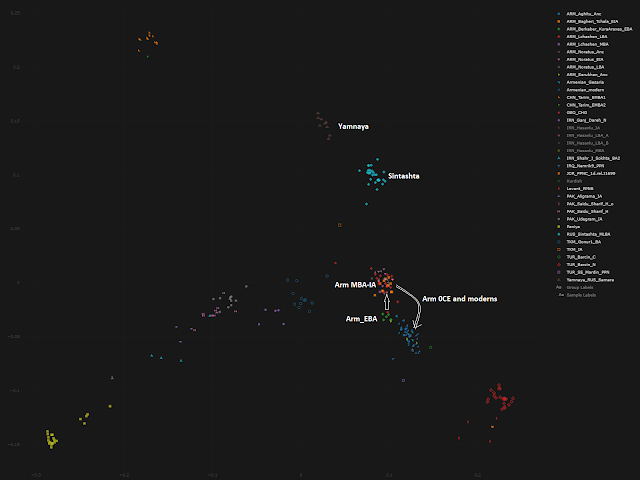The Armenian Data from the new papers
1. Some EHG ancestry from north of caucasus is seen at Areni Cave, 4200BCE.
2. EHG dilutes by the time of Kura Araxes 3600-2000BCE, Arm_EBA (green below).
3. Arm_MBA/LBA/IA cluster clearly shifts towards steppe, with lots of R1b & I2 Y hg. According to Lazaridis et al, this explains the Armenian language branch. For now I will accept this conclusion as it makes sense, and explains the different language of NW Iran.
4. Post IA, intense mixing with more southwestern populations (but not NW Iran) so much so that all steppe autosomal ancestry gets diluted.
 |
| PCA - Ancient & Modern Armenia |
Contrast with NW Iran & Kurds
2. By 1400 BCE, there evidence of massive migration by BMAC like people which is seen in Hasanlu_LBA_A. LBA_B sample is very similar to Hasanlu_MBA (BMAC connection was already confirmed by archaeology, check previous post)
3. The 1200-800BCE Hasanlu_IA samples are an admixture between LBA_A and LBA_B like samples, with maybe some input from Armenia_MBA/LBA.
5. At least 1 sample, I6430, has 20% ancestry from IVCp. (Mitanni connection, check previous post). Other sample has Y hg L1a2, found in Swat at the same time.
4. Modern Kurds fall inside the Hasanlu_IA cluster, very little pull seen towards steppe, unlike in BA Armenians.
 |
| G25 PCA: Zagros ancients and moderns |
Armenia & NW Iran are neighbouring regions, but we see different stories play out - one gets Yamnaya ancestry whereas the other gets BMAC ancestry. The first speaks the Armenian branch whereas the second speaks the Iranian dialect.
That ends these two short stories. Later.
Please see this for date of steppe dna in India: https://www.academia.edu/86209880/The_first_horse_herders_and_the_impact_of_early_Bronze_Age_steppe_expansions_into_Asia?fs=bw-5665039953&iid=19d3b7c3-a8b2-4402-b600-1c624fb877c4
ReplyDelete@anon
ReplyDeleteThe Damgaard paper has no sample from India, not sure what it can say about steppe DNA in India with certainty.
When do you think Indo European languages entered or appeared in India
ReplyDeleteWhenever IranN related ancestry entered India. Timing we will know only when relevant samples are published.
ReplyDeleteWhat about horse domestication and metallurgy. Proto Indo Europeans had some knowledge of bronze. Could you express in layman’s terms why PIE is IranN and not Steppe
ReplyDeleteHorse domestication is not known to PIE folks, only the presence of horse is known. Anatolian languages which are first to split, show no special importance to the horse. Metalwork is present from early on at various sites in Eurasia.
ReplyDeletePIE is IranN and not steppe because there is almost 0 presence of steppe ancestry or uniparental markers in 50+ samples from Anatolia over various periods, however Anatolia does receive a lot of IranN related ancestry from the east post 4500bce, perfect time as this is considered the time for Anatolian split.
At or around the same time, iranN related ancestry also goes north to the steppe to form the steppe_eneolithic and later yamnaya ancestries. This is what Lazaridis et al says.
does IranN mean Iranian Neolithic, because that might be Elamo-dravidian
ReplyDelete"does IranN mean Iranian Neolithic, because that might be Elamo-dravidian"
ReplyDeleteYes it does mean Iran_Neolithic, and no it is not Elamo Dravidian (which is a fake thing to begin with) because IranN left the Elamite area post 6000bce and the whole Zagros region and to its south was taken over by Iraq_PPN like ancestry.
But the IranN ancestry reached India between 11000 to 8000 years ago. This is too old for Priti Indo European.
ReplyDelete"But the IranN ancestry reached India between 11000 to 8000 years ago. This is too old for Priti Indo European."
ReplyDeleteThere is a second wave which brought Anatolian/PPN ancestry. Already covered by Maier et al 2022. https://www.biorxiv.org/content/10.1101/2022.05.08.491072v1.full
Also covered in my previous recent blogposts on IVC and rakhigarhi.